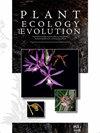坎贝尔岛(亚南极)历史苔藓植物样本中硅藻组合的分类学和生物地理学分析
IF 1.1
4区 生物学
Q3 PLANT SCIENCES
引用次数: 0
摘要
背景和目的——在过去的二十年里,亚南极地区的非海洋硅藻区系进行了深入的修订。历史藏品为回答分类学、群落相关和生物地理学问题提供了极好的工具。这项研究分析了1969年至1970年从英国南极调查局植物标本馆(英国剑桥)采集的样本中来自亚南极坎贝尔岛的苔藓硅藻群落。通过这项研究,我们试图扩大我们对南太平洋苔藓硅藻区系的了解。材料和方法——总共使用光学显微镜(LM)和扫描电子显微镜(SEM)分析了32个苔藓样品中的硅藻成分。对坎贝尔岛硅藻区系进行了生物地理学分析和群落分析。关键结果——对坎贝尔岛硅藻区系的分析显示,共有45属141个分类群。优势属Planothidium、Humidophila和Psammothidium的物种组成,Epichemia、Rhopalodia、Cocconeis的存在,在亚南极地区并不常见,许多未鉴定的分类群表明坎贝尔岛硅藻区系的独特性。生物地理学分析显示,与其他亚南极和南极海洋岛屿的相似性总体较低。根据群落分析,区分了四种不同的硅藻组合。湿度水平和栖息地类型似乎是形成坎贝尔岛硅藻群落的主要因素。结论——坎贝尔岛硅藻分析的结果突出了历史植物标本馆材料的重要性。由于所检查的植物群主要由未知(可能是新的)物种组成,因此分析额外的(历史)样本以完成对坎贝尔岛苔藓硅藻组合的评估至关重要。本文章由计算机程序翻译,如有差异,请以英文原文为准。
Taxonomic and biogeographical analysis of diatom assemblages from historic bryophyte samples from Campbell Island (sub-Antarctic)
Background and aims – The past two decades, the non-marine diatom flora in the sub-Aantarctic region has been intensively revised. Historic collections provide excellent tools for answering taxonomic, community-related, and biogeographical questions. This study analysed the moss-inhabiting diatom flora from sub-Antarctic Campbell Island in samples collected in 1969–1970 and retrieved from the British Antarctic Survey herbarium (Cambridge, UK). With this study we attempt to expand our, till now sparse, knowledge on the moss-inhabiting diatom flora in the southern Pacific Ocean.Material and methods – In total, the diatom composition in 32 moss samples has been analysed using Light Microscopy (LM) and Scanning Electron Microscopy (SEM). A biogeographical analysis and community analysis of the Campbell Island diatom flora were conducted.Key results – Analysis of the Campbell Island diatom flora revealed the presence of 141 taxa belonging to 45 genera. The species composition in the dominant genera Planothidium, Humidophila, and Psammothidium, the presence of Epithemia, Rhopalodia, Cocconeis, uncommon in the sub-Antarctic region, and many unidentified taxa point to the uniqueness of the Campbell Island diatom flora. The biogeographical analysis showed an overall low similarity with the other sub-Antarctic and the Maritime Antarctic islands. Four different diatom assemblages were distinguished following the community analysis. Moisture level and habitat type seem to be the main factors shaping the Campbell Island diatom assemblages.Conclusion – The results of the Campbell Island diatom analysis highlight the importance of historic herbarium material. Since the examined flora is largely composed of unknown (presumably new) species, it is vital to analyse additional (historic) samples to complete the assessment of the moss diatom assemblages from Campbell Island.
求助全文
通过发布文献求助,成功后即可免费获取论文全文。
去求助
来源期刊

Plant Ecology and Evolution
PLANT SCIENCES-
CiteScore
2.20
自引率
9.10%
发文量
27
审稿时长
>12 weeks
期刊介绍:
Plant Ecology and Evolution is an international peer-reviewed journal devoted to ecology, phylogenetics and systematics of all ‘plant’ groups in the traditional sense (including algae, cyanobacteria, fungi, myxomycetes), also covering related fields.
The journal is published by Meise Botanic Garden and the Royal Botanical Society of Belgium.
 求助内容:
求助内容: 应助结果提醒方式:
应助结果提醒方式:


